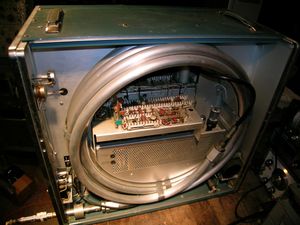519: Difference between revisions
Jump to navigation
Jump to search
No edit summary |
(added input connector and horizontal) |
||
| Line 1: | Line 1: | ||
The Type 519 is a high-speed oscilloscope made by Tektronix from the late 1950's to the early 1970's. It is very unusual in that it does not contain vertical amplifiers. The input signal is passively connected to the vertical deflection plates of the CRT. This allows the scope to have 1GHz bandwidth. | The Type 519 is a high-speed oscilloscope made by Tektronix from the late 1950's to the early 1970's. It is very unusual in that it does not contain vertical amplifiers. The input signal is passively connected to the vertical deflection plates of the CRT. This allows the scope to have 1GHz bandwidth. The input to the 519 has an impedance of 125 ohms. The input connector is a special 125-ohm GR connector that is not electrically or mechanically compatible with the much more common 50-ohm connector. | ||
To allow viewing of the rising edge of pulses, there is a coaxial delay line between the input and the CRT. | To allow viewing of the rising edge of pulses, there is a rigid coaxial delay line between the input and the CRT. [[Image:519delay.jpg|thumb]] | ||
[[Image:519delay.jpg|thumb]] | |||
The horizontal deflection voltage of a 519 is generated by a lighthouse-style RF tube. | |||
Revision as of 09:29, 7 December 2008
The Type 519 is a high-speed oscilloscope made by Tektronix from the late 1950's to the early 1970's. It is very unusual in that it does not contain vertical amplifiers. The input signal is passively connected to the vertical deflection plates of the CRT. This allows the scope to have 1GHz bandwidth. The input to the 519 has an impedance of 125 ohms. The input connector is a special 125-ohm GR connector that is not electrically or mechanically compatible with the much more common 50-ohm connector.
To allow viewing of the rising edge of pulses, there is a rigid coaxial delay line between the input and the CRT.

The horizontal deflection voltage of a 519 is generated by a lighthouse-style RF tube.